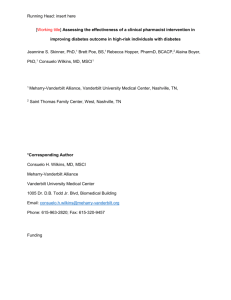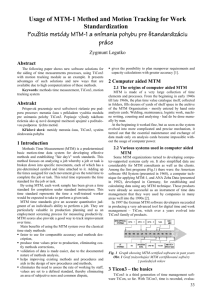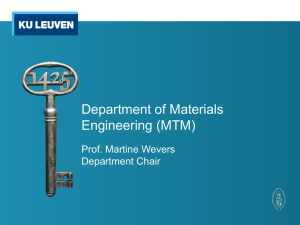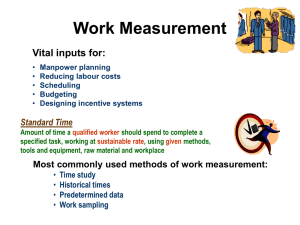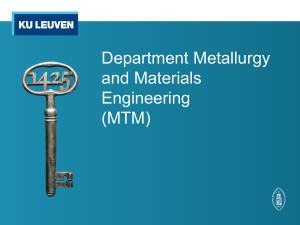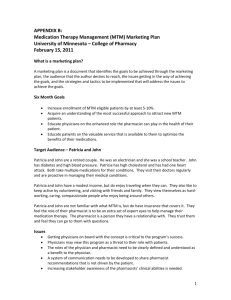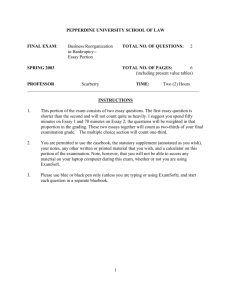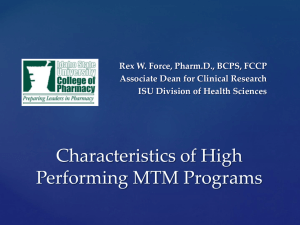Atmospheric Particulate Matter in Proximity to Mountaintop Coal Mines
advertisement
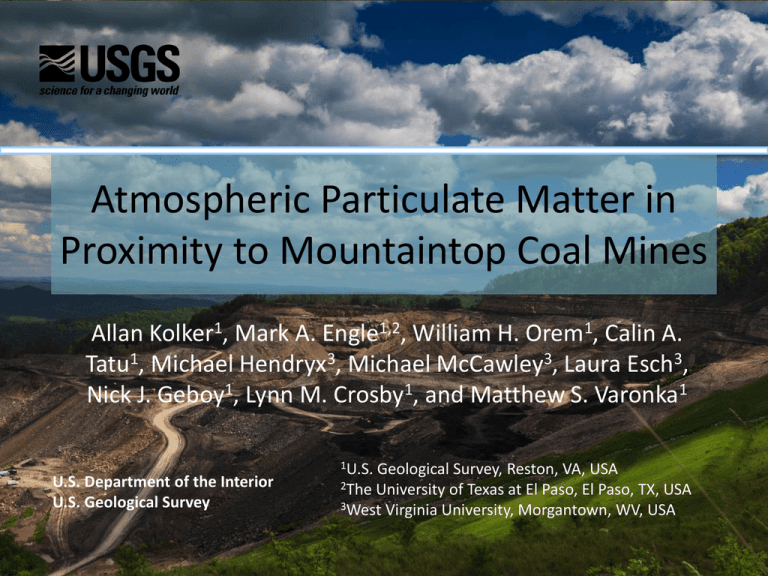
Atmospheric Particulate Matter in Proximity to Mountaintop Coal Mines Allan Kolker1, Mark A. Engle1,2, William H. Orem1, Calin A. Tatu1, Michael Hendryx3, Michael McCawley3, Laura Esch3, Nick J. Geboy1, Lynn M. Crosby1, and Matthew S. Varonka1 U.S. Department of the Interior U.S. Geological Survey 1U.S. Geological Survey, Reston, VA, USA University of Texas at El Paso, El Paso, TX, USA 3West Virginia University, Morgantown, WV, USA 2The Introduction • Mountaintop mining (MTM) is a common method of coal extraction in parts of the U.S. Appalachian region. • The method exposes coal for production by explosion and removal of non-coal bearing siliceous overburden. • Past studies have primarily concerned the impact of overburden disposal in stream valleys on aquatic life. • Recent epidemiologic work suggests disparities in the rates of some diseases between comparable MTM and non-MTM areas1. 1Hendryx et al., 2011, J. Community Health Approach • The present study considers the potential for human exposure to air- and water-sourced contaminants from MTM activities. • Initial results from air sampling studies are presented here. • Samples collected include: 1) 2) 3) High-volume 24-hour sampling of sized ambient particulate matter. Separate inorganic and organic sampling. Geochemical window-wide samples for inorganic and organics. Extended sampling on greased surrogate deposition surfaces. • Study compares active MTM areas with internal (coal mining by other methods) and external (no coal mining) controls. Study Area • Study area in south central West Virginia (WV), USA. • Control areas in southern WV (internal control) and southeastern WV (external control). • Sampling in June, Aug., Dec., 2011; Feb., May, 2012 • Results to date for 2011. PA OH MD WV VA Sampling Activities Exposed TSP Filters MTM INT. CNTRL. Total suspended particulate (TSP) samplers EXT. CNTRL. Sampling Activities Geochemical window wipes Greased surrogate deposition surfaces Comparison of MTM Areas E and T with External Control (June, 2011) Anthropogenic Sources Crustal Sources June, 2011 V As Cd Al Ga Rb Ce E/EC fine T/EC fine E/EC coarse T/EC coarse 2.4 1.7 ND ND 1.8 1.6 ND ND 2.0 1.7 2.4 3.4 15.8 8.4 9.5 7.5 20.1 12.1 6.8 5.5 9.3 5.2 7.6 5.6 10.6 6.5 10.1 5.9 Results indicate more pronounced enrichment in “crustal” elements (e.g. Al, Ga, Rb, Ce) in MTM areas E and T vs. external control (EC). Comparison of MTM Areas E and T with Internal Control (August, 2011) Anthropogenic Sources Crustal Sources Aug., 2011 V As Cd Al Ga Rb Ce E/IC fine T/IC fine E/IC coarse T/IC coarse ND ND ND ND 1.2 0.90 ND ND 0.90 2.1 2.7 1.3 1.1 1.4 0.73 1.2 0.28 0.39 0.69 1.2 1.1 1.3 0.90 1.1 1.1 1.4 0.74 1.1 Results indicate similar enrichment in most “crustal” elements (e.g. Al, Ga, Rb, Ce) in MTM areas E and T vs. internal control (IC). Comparison of MTM Area S with Internal and External Controls (December, 2011) Anthropogenic Sources Crustal Sources V As Cd Al Ga Rb Ce S/IC fine 22 5.6 5.3 37 11 17 49 S/EC fine 14 3.1 2.7 15 8.3 13 20 S/IC coarse 25 ND 3.4 20 23 14 46 S/EC coarse 13 ND 4.4 25 23 24 20 Dec. 2011 Results indicate higher concentration of nearly all constituents in MTM area S vs. internal (IC) and external (EC) control sites. Comparison of WindowWipe Samples in MTM Areas and Controls (June and August, 2011) MTM Int. Cntrl. Ext. Cntrl Anthropogenic Sources Crustal Sources V As Cd Al Ga Rb Ce 0.59 0.89 2.39 120 490 382 17 50 33 0.26 0.30 0.40 0.46 0.42 0.58 0.26 0.36 0.55 1 1 1 Results indicate enrichment in “anthropogenic” elements (Se, As, Bi, Cd, Ni, Sn) is less in MTM areas than internal control, consistent with dilution by “crustal” material in proximity to MTM operations. Window Wipe from MTM area GC-MS Total Ion Chromatogram 5000000 4500000 2500000 2000000 1500000 Benzo[a]pyrene 3000000 Chrysene Anthracene 3500000 Benzo[a]fluoranthene Heptacosane 4000000 1000000 Benzo[ghi]perylene 5500000 Indeno[1,2,3-cd]pyrene 6000000 Hentriacontane 6500000 Results for organics in MTM areas are dominated by alkylated low mol. wt. compounds and low mol. wt. PAH’s (circled) indicating contribution by a coal source, as opposed to coal combustion. Nonacosane 7000000 Fluoranthene 7500000 Heneicosane Pyrene Hexadecanoic acid 8000000 Benzyl butyl phthalate 8500000 1,2-Benzenedicarboxylic acid, mono(2-et TIC: 042312122011-OW-11-200uL.D\data.ms Abundance 9000000 500000 Time--> 8.00 10.00 12.00 14.00 16.00 18.00 20.00 22.00 24.00 26.00 28.00 30.00 32.00 34.00 36.00 38.00 40.00 42.00 44.00 46.00 48.00 50.00 52.00 54.00 Hi-Vol Fine Air Filter from MTM Residential Property GC-MS Extracted Ion Chromatogram 2000000 1800000 1600000 1200000 1000000 800000 Benz[a]anthracene Chrysene Phenanthrene 1400000 600000 400000 200000 Benzo[ghi]perylene 2200000 Benzo[a]fluoranthene \ Benzo[k]fluoranthene 2400000 Pyrene Ion 178.00 Ion 202.00 Ion 228.00 Ion 252.00 Ion 276.00 2600000 Benzo[e]pyrene Benzo[a]pyrene Perylene 2800000 Indeno[1,2,3-cd]pyrene Fluoranthene Abundance 0 Time--> 8.00 10.00 12.00 14.00 16.00 18.00 20.00 22.00 24.00 26.00 28.00 30.00 32.00 34.00 36.00 38.00 40.00 42.00 44.00 46.00 48.00 50.00 52.00 54.00 Conclusions • Proportions of crustal elements in MTM areas studied are greater than, or similar to, those in external and internal controls, respectively. • Concentrations of anthropogenic elements derived primarily from combustion sources, are proportionally lower in MTM areas relative to control areas. • These results are consistent with dilution of anthropogenic elements by locally-derived siliceous material. • Organics are dominated by low molecular weight alkylated compounds consistent with derivation from coal itself rather than coal combustion. Ongoing Work • Integrate air- and water quality sampling. • Further use of surrogate surfaces to obtain time-integrated particulate samples. • Integrate environmental sampling with epidemiologic studies conducted by WVU. • Focus environmental sampling on specific communities with evidence of health impacts.

![Masood Textile Mills [Erum Zahoor]](http://s2.studylib.net/store/data/005544654_1-c63f8378e6188468be9b937fd88ad22c-300x300.png)
